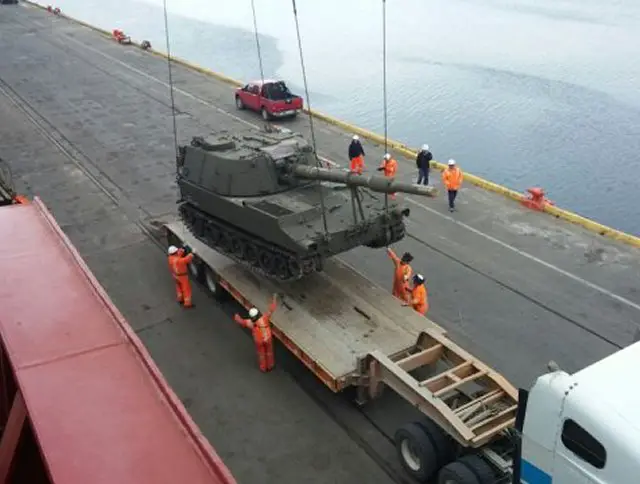Breaking news
Chile's armed forces receive 12 M109A5 Paladin 155mm self-propelled howitzers.
|
|
|||
|
Defence & Security News - Chile & United States
|
|||
|
|
|||
| Chile's armed forces receive 12 M109A5 Paladin 155mm self-propelled howitzers | |||
|
Twelve M109A5 howitzers were delivered to Punta Arenas in Southern Chile Dec. 8 as part of the U.S. Army Security Assistance Command's foreign military sales program. The howitzers were subsequently transferred to the Artillery Group No. 7 "Wood", 4th Armoured Brigade "Chorrillos" of the 5th Army Division.
|
|||
|
|
|||
 A M109-A5 howitzer is offloaded and craned onto a trailer at the port in Punta Arenas, Chile, in Dec. A M109-A5 howitzer is offloaded and craned onto a trailer at the port in Punta Arenas, Chile, in Dec. |
|||
|
|
|||
|
With the arrival of this material, the Chilean Army standardizes its self-propelled artillery with the M109, ending the replacement process of French-made AMX-13 155 mm self-propelled howitzers, acquired by the country at the end of the 1970 and served in southern and northern garrisons.
Declared Excess Defense Articles, the howitzers proved a win-win for both the Chilean army and the United States. EDA are equipment that are excess to US Army requirements or no longer part of the Army inventory and have been designated available to approved international partners through the FMS process. "As our Army gets smaller, we have high-quality, serviceable equipment that we no longer need, so we are able to offer some of these items to our partner nations as an EDA grant or at a reduced price," said Col. Steve Smith, director of US SOUTHCOM regional operations at USASAC. "This helps our partners fill a significant capability gap while providing us numerous benefits that include interoperability with U.S. systems and the creation of American jobs through the refurbishment process." Smith said the Chilean Army's recent howitzer purchase was a major upgrade for their land forces and one of many steps they've taken over the last five years to modernize their military. He said the howitzers will be fielded to a brigade, drastically extending their army's artillery range. Smith called the interoperability advantage invaluable, noting that two armies working with the same equipment is critical during both peace time and war. "If we ever needed them to assist us, or if we became part of a coalition, we know that the equipment is interchangeable, resulting in fewer repair parts we'd have to have on the battlefield; we both have Soldiers who know how to use that equipment; and we can join with them to conduct artillery shoots and other training." USASAC Southern Command Program Manager Lenard Dotson said the December delivery was the second batch of 12 howitzers delivered to the Chilean Army under FMS, bringing the total number of the U.S.-provided combat support weapons systems to 24. He said the case was historic because it was the Chilean Army's first major FMS case with the United States. As part of the FMS process's total package approach, USASAC also provided training and coordinated the delivery of spare parts for the howitzers. |
|||


























